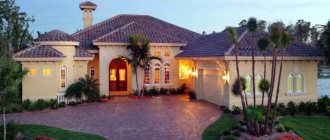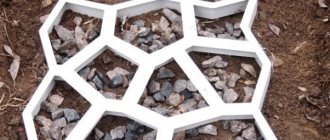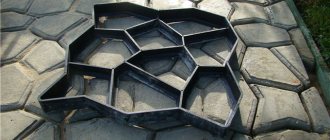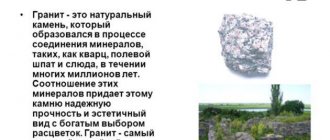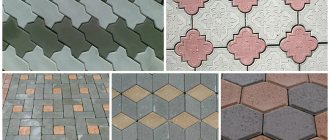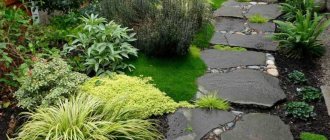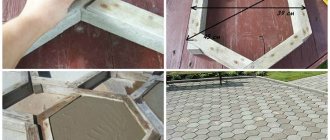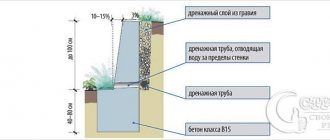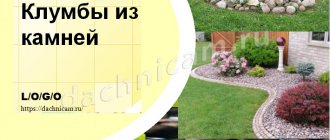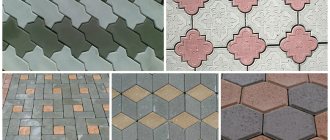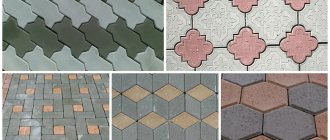Polyurethane molds for the production of decorative stone
If you have a desire or need to buy molds for making decorative stone, then you are probably faced with the problem of choosing the material from which these forms will be made. Let's look at what they are:
- plastic molds (polypropylene, ABS)
- polyurethane (with and without additives (fillers))
- silicone molds (with and without additives (fillers))
- rubber (Thermoplastic vinyl (PVC plastic), etc.)
All types of molds for the production of decorative materials will have different costs (the difference can reach 5-10 times), durability, practicality, ease of use and the ability to clearly convey the structure of the stone.
Plastic molds are the cheapest option, with a lifespan of approximately 200 castings. They do not convey the natural structure of the stone well; products made from them look “washy.” Another disadvantage is that the plastic plaster stone mold product is difficult to remove without damage. They are more suitable as forms for making paving slabs, curbs, and paving stones. But behind the cheapness lies the need for frequent replacement. Be careful.
Silicone molds for artificial stone are used in the manufacture of decorative stone from gypsum and polymer resins. Such forms do not like the alkaline environment of cement, where they quickly collapse. The resource is already more acceptable - from 500 to 800 castings from one mold. They copy well the structure of natural materials, including possible negative angles.
Polyurethane forms are the most popular and versatile. With such forms, you can use any source material - gypsum, cement, casting resin. But here you definitely need to use a release agent. It is also possible to cast from 500 to 800 products using such molds. The cost of such a mold for polyurethane brick or stone is greatly influenced by the additives and fillers that are used when casting the molds. Polyurethane forms without fillers will have the greatest resource, but they will also have the highest cost.
Rubber molds (thermoplastic vinyl) are also universal, i.e. can be used when working with gypsum, cement and resins. They have the longest working life among all bending forms - up to 2000 castings. Rubber molds do not require a release agent to work with artificial stone on any binder. The price tag for thermoplastic vinyl molds is even less than for polyurethane ones, but their production requires special complex equipment and heat-resistant matrices, so this is not feasible in small workshops.
Considering all the pros and cons of various types of forms for artificial stone and finishing bricks, polyurethane models become the best solution, as they are the most versatile and durable.
for artificial stone
- The advantage of using a flexible mold for artificial stone.
- Do-it-yourself artificial stone - price and choice of materials for production.
- How to properly paint artificial stone.
- Making molds for artificial stone to order.
- Surface and volumetric hydrophobization to protect artificial stone.
The advantage of using a flexible mold for artificial stone
If you decide to make it yourself or buy artificial stone for interior or exterior decoration, the main criterion will be maximum resemblance to natural stone and its durability. The similarity is ensured by the correct choice of shape for the stone and its color. Real stone has microcracks, chips, holes, negative angles, and inexpensive plastic molds (made of polypropylene or ABS) will not be able to convey such a texture, given the properties of the material and the method of making the molds. Hard plastic molds for stone are short-lived and it is difficult to remove the finished artificial stone from them without damage, given the small thickness (and thickness means the weight that must be fixed to the wall!). Therefore, to make artificial stone, it is better to use elastic forms.
Review of mold materials for the manufacture of decorative stone
If you decide to buy molds for making artificial stone, you will be faced with a choice of molds from various materials:
- plastic (polypropylene, ABS)
- polyurethane (with and without additives (fillers))
- silicone (with and without additives (fillers))
- rubber (Thermoplastic vinyl (PVC plastic), etc.)
The forms have different costs (5-10 times different), durability, the ability to convey the texture of the stone, and ease of use.
Plastic molds are the cheapest, but have a lifespan of no more than 200 castings, do not convey the texture of the stone well, the pattern is blurry, and it is difficult to remove the finished product from a plastic mold for plaster stone without damage. Mainly used for making paving slabs, paving stones, curbs and MAFs.
Silicone molds for artificial stone are used for the production of decorative stone from gypsum and polymer resins. They are destroyed in the alkaline environment of cement. Resource 500-800 castings. Accurately convey texture, including negative angles.
Polyurethane molds are universally used. Cement, gypsum, casting resins. Requires the mandatory use of a release agent. Resource up to 500-800 castings. The cost and resource are greatly influenced by the use of fillers in polyurethane. Polyurethane molds for artificial stone without fillers have a long service life, but also the highest cost.
Rubber molds (Thermoplastic vinyl) are universal molds for stone made of gypsum, cement and polymer resins. They have the maximum service life for flexible molds - up to 2000 castings. They do not require a release agent for the production of artificial stone using any binder. The price of molds for artificial stone made of Thermoplastic Vinyl is less than the price of polyurethane or silicone molds due to the lower cost of raw materials. But the production of rubber molds requires complex equipment and heat-resistant matrices and is not feasible at home. It is much easier to make silicone and polyurethane molds with your own hands, but you will need expensive raw materials, which leads to the high cost of molds made from these materials.
Considering the durability of PVC rubber molds, the reduction in time and cost of the operation of applying a release agent, choosing a thermoplastic vinyl mold for stone made of gypsum, cement or polymer resin will be the best solution.
Do-it-yourself artificial stone - price and choice of materials for production.
Artificial stone can be purchased with a price range of up to 300% or more. What determines the price and how to make artificial stone inexpensively and not lose in quality? Unscrupulous manufacturers use cement and gypsum of low grades, without modern strengthening additives, and use cheap and short-lived dyes in order to reduce costs. And therefore, a worthy alternative to buying is to make an artificial stone with your own hands.
The production of artificial stone is not a complicated process, it can be done at home and requires minimal equipment. An exception is the quartz agglomerate technology, which is used to make kitchen countertops and sinks that are stronger than natural granite. But for the production of artificial stone for interior decoration, such strength is not required.
How to make artificial stone. Production price.
For production you need to buy molds for making artificial stone. You will also need equipment for preparing the mixture (mixer, concrete or mortar mixer) and the actual components for preparing the appropriate mixture. Depending on the type of binder, 3 basic mixture compositions are used for the manufacture of decorative stone:
- cement (gray, white) + filler (sand, screenings) + water + additives (plasticizer, fiber, pigment, water repellent). C:P (cement-sand) ratio = from 1:2 to 1:3
- polymer resin (acrylic, epoxy, polyester) + filler (sand, screenings) + additives (fiber, pigment, decorative chips). Resin content from 15 to 30%
- gypsum + water + additives (plasticizer, fiber, pigment, water repellent). Water-gypsum ratio 20-50% (water by weight of gypsum).
Now let’s determine what affects the cost of artificial stone production:
- cost of binder (gypsum, cement, resin)
- cost of inert filler (sand, screenings)
- cost of additives (plasticizers, pigments, water repellent, micro-reinforcing fiber)
The cost of aggregate filler has minimal impact. The main costs are the cost of the binder and the amount of binder in the mixture for artificial stone:
- Cement (25-30% by weight of the mixture) - 15 rubles / kg. (white) and 5 rub./kg. (grey)
- Gypsum (60-80% by weight of the mixture) - 6 rubles / kg. (G-5) and 12 rub./kg. (G-16)
- Resin (15-30% by weight of the mixture) - 190-260 rubles/kg.
Thus, the minimum cost is achieved by producing artificial stone based on a cement-sand mixture. The most expensive option is acrylic artificial stone. The use of various additives and especially pigments also has a significant impact, increasing the cost of artificial stone by 15-40% of the cost of the binder with the filler.
The type of binder affects the range of applications of the finished stone and the productivity of the production process:
- Cement is an artificial stone for interior and exterior decoration. Wet areas. Productivity: product removal in 24-48 hours.
- Gypsum is a decorative stone for interior decoration of dry rooms. When using additives (*), external use is possible with certain restrictions. Productivity: eat products in 60-120 minutes.
- Casting resins are an artificial stone for interior and, with restrictions, for exterior decoration. Not resistant to UV radiation without special additives. Wet areas. Productivity: product removal after 24 hours.
The least durable and moisture resistant are gypsum mixtures. But at the same time, the production of artificial stone from gypsum is as productive and simple as possible. Having a small number of molds, you can quickly produce a large volume of artificial stone. This is why gypsum stone molds are most in demand. The Legobeton online store offers you to buy molds for gypsum stone made from Thermoplastic Vinyl, which also work great with a cement or polymer binder.
(*)The finishing of dry rooms with artificial stone made of gypsum is associated with its high water absorption, amounting to 15% or more (for comparison, for artificial stone based on casting resins and cement, 0.5-6%). This parameter can be adjusted by adding a hyperplasticizer, which reduces the required amount of water by almost 2 times, thereby ensuring a greater density of the mixture. Cement can be added and volumetric hydrophobization can be carried out, which also reduces water absorption several times. This complex of additives significantly increases the strength and water resistance of gypsum stone. But nevertheless, decorative artificial stone made of gypsum will be less moisture resistant than stone made with cement binder or casting resins.
You can learn more about how to make artificial stone by contacting our specialists. We advise you on all stages of production and help you with the optimal selection of mixtures and methods of coloring the stone.
How to paint artificial stone correctly
It is the correct and high-quality coloring of the artificial stone that is the second factor that ensures the similarity of the manufactured artificial stone with the natural one. Depending on the choice of material for the manufacture of decorative stone and where the finished stone will be used, various painting methods and dyes themselves are selected. The influence of light (UV radiation), atmosphere (precipitation, temperature changes), and external influences (abrasion, scratches) are taken into account. For painting artificial stone use:
- Iron oxide pigments (coloring in the mass and surface coloring of the mold for any type of binder). The most resistant and durable pigment. Products painted in the paste do not lose their appearance if the surface is mechanically damaged.
- Acid dye for concrete (surface coloring of ready-made artificial stone made of cement). Most realistically conveys the natural color range of natural stone due to different absorption and concentration of cement. Painting depth 0.1-1.5 mm. Not suitable for painting plaster.
- Tinting pastes and other types of organic water-based dyes (surface coloring of decorative stone or color is applied to the mold before pouring or to the finished gypsum stone). Allows you to achieve smooth color transitions due to uneven absorption. Inexpensive, but limited for indoor use in dry areas.
- Concrete dyes made from light-resistant iron oxide inorganic pigments on a polyurethane or epoxy base . They give the most uniform coloring, reducing the realism of the stone. Used for surface painting of finished artificial stone for outdoor use.
A combination of techniques and dyes can be used to achieve the most realistic and long-lasting options. For example, they paint the stone one color in the mass and add surface coloring with an acid dye to the finished stone or coloring the mold with another pigment before pouring the mixture. The cost of the combined method (painting the mold for artificial stone and a separate mixture) is maximum (taking into account the cost of dyes, additional production operations and washing the mold from pigment residues), but a realistic, long-lasting effect is achieved that is not lost due to mechanical damage or abrasion of the surface.
Making molds for artificial stone to order
Our catalog presents a variety of flexible forms for artificial stone, which can be purchased in Moscow for pick-up or with delivery to anywhere in Russia. The catalog is constantly expanding both in range and types of forms. If you could not find a suitable thermoplastic vinyl mold in our catalog and you have a ready-made sample, we are ready to make a rubber, polyurethane or silicone mold to order. Taking into account the matrix manufacturing process, we undertake the production of molds from:
- silicone - from 3 m2 of stone yield),
- polyurethane (from 3 m2),
- thermoplastic vinyl (rubber) (from 10m2)
Making durable and versatile molds from PVC (thermoplastic vinyl) is a more complex and expensive process than making molds for wall stone from silicone or polyurethane. Therefore, the minimum order quantity is larger, but the price of such forms will be lower, and the consumer qualities of flexible rubber forms are superior to silicone and polypropylene.
Surface and volumetric hydrophobization to protect artificial stone from moisture.
An additional increase in the service life of artificial stone made from cement and especially gypsum can be achieved by introducing a water-repellent organosilicon impregnation into the mixture for artificial stone - the water repellent "Aquasil" (concentrate) in an amount of 0.4–0.5% by weight of the binder (cement, gypsum). Also, an aqueous solution of a water repellent (1:10) is used for surface treatment of new artificial stone or purchased and laid previously.
The use of water repellent "Aquasil" will protect the finished decorative stone from moisture, which will increase the frost resistance of the product and maintain the richness of the color. The use of the water repellent "Aquasil" reduces the water absorption of concrete by 10 times, and of gypsum products by 30-40 times.
In the Legobeton online store you can cheaply buy molds for artificial stone in Moscow or with delivery throughout the Moscow region and Russia. Convenient pickup from a warehouse near the Khoroshevo metro station. In addition to elastic molds for stone and paving stones, you can purchase all the necessary additional materials from us (dyes for gypsum and concrete, hyperplasticizers, reinforcing fiber, water repellents). Our consultants will help you both at the selection stage and during the production of artificial stone.
